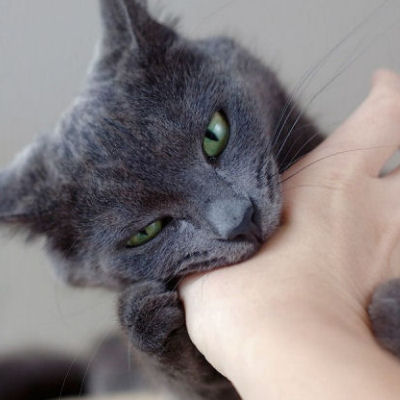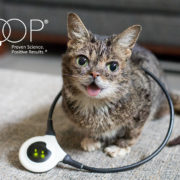Understanding your cat can help you both understand aggression and work with your cat to avoid situations where he or she may become aggressive. An aggressive cat can be dangerous, especially toward children who may not be able to recognize the physical cues that are the warning signs. Additionally, cat bites and scratches are painful and can transmit disease. Neutering males before they reach maturity is definitely a must in lowering aggression.

Grab a copy of our FREE eBook below to keep on hand for your reference. It’s full of useful information and tips on dealing with aggressive cat behavior.
What Triggers Aggression
There is a real difference between play aggression, which is a normal behavior in kittens over about five weeks of age as they become independent hunters and work towards being able to exist on their own in the world and aggression that will be problematic. In domestic cats this stage of aggression in development still occurs, even though your cat will never have to hunt its own dinner. In addition to the play aggression stage, at about the age of 14 weeks kittens will start to learn about social fighting, which is again a survival of the fittest learning skill that will determine which males will successfully mate with females, passing on their physical characteristics.
A kitten that is involved in either play social fighting or play hunting aggression will hide or couch down, leap out at you and swat at your feet or ankles or bite, then immediately run off. If not stopped this behavior will continue to escalate over time until it become a serious problem with a full grown cat attacking your feet when you walk past. Aggression can be triggered by specific situations that may occur in the home. In their wild state cats respond to sudden noises and feeling trapped or cornered in one of two ways – fight or flight. In most cases a cat will run away if they feel threatened, however if they can’t escape, they will resort to aggression. Typically this type of aggression can be avoided by simply stepping away and giving the cat time and space to become comfortable again.
There are some cats that are just more aggressive by nature. These may be cats that have been mistreated, feral cats that have the only partially tamed or domesticated after they matured, cats that have an illness or injury or those that need to feel that they are the “top cat”. This behavior is known as status-related aggression and can cause serious injury to people, other pets and even other cats in the house.
Cats sometimes seem to be truly bipolar in their behavior. Once second they may be sitting contentedly on your lap and purring and the next second they have your thumb between their teeth and their claws firmly lodged in your leg. This type of an instantaneous change from calm to aggressive is more likely in the status-related aggression, where the cat is letting you know he or she is the boss.

For most cats the signs and signals of aggression include their body movements, vocalizations and general behavior. As mentioned above most cats will try to get away from trouble, not actively pick a fight with another animal or a person. If a cat feels trapped or cornered, watch for signs of the ears pulled back along the head, hissing and spitting, widely dilated pupils, arched back and the tail standing straight up and bushed out like an old fashioned bottle brush.
Cats may also indicate dissatisfaction and potential aggressive behavior by their tail movements. A gently swaying tail tends to indicate a happy, relaxed and contented cat whereas a wildly twitching or just the tip of the tail jerking back and forth will indicate that the cat has had enough of whatever is going on. Purring cats that suddenly stop purring or switch from purring to a more high-pitched vocalization like a growling or yowling sound may also be indicating that they are about at the end of their tolerance range. A content purr is a very deep, rumbling sound that appears to be coming from their chest or the center of their body, a growl or hiss of displeasure is from the back of the throat.
Aggression towards other cats or animals is very similar to aggression from being startled. The cat will try to arch his or her back, puff out their hair and look as ferocious as possible to hopefully get the other cat or animal to back down and go away. Once cats move into the attack mode cat aggression can be very damaging and it is not a wise idea to stick your hands in between two fighting cats or a cat and a dog. If at all possible distract the animals with a loud noise or a spray of water and then move between then. Sticking your hands on or between animals that are fighting each other is a potential risk that can result in very serious injuries, even though the animals would never hurt you under normal conditions.
Correcting Aggressive Behavior
Kittens learn from playing with their mothers and litter mates that if they are too rough they will be corrected, or they will be left without anyone to play with. Correcting aggressive behavior with kittens, even as a human, needs to follow those same rules. When a kitten first starts to show any aggressive type of play, simply stop playing. You may also want to indicate a sharp “Ouch” or “No” when the kitten bites or uses their claws. Immediately give the kitten a toy and allow him or her to understand that rough play is for the toys, not for the people. Don’t hit or spank the kitten and don’t pick it up by the scruff of the neck and give it a shake, no matter what you might read. This will only increase the kittens struggling and reinforce that aggression is the way to handle human interactions. If the kitten doesn’t respond to the sharp “No” and ignoring, consider carrying a small misting bottle filled with clean water and direct a small shot of water at the kitten’s nose when he or she becomes aggressive. Don’t use water as a toy or to tease or play with the kitten and only use when necessary.
Mature cats are more likely aggressive either because they are frightened or because they feel that they are the boss of the house. If your cat is frightened, increasing socialization such as regular petting, grooming and attention may help to solve the problem. If you cat’s behavior has changed due to a move or change in the house, you may need to provide a private, quiet place and give the cat time to adjust.

Status-aggressive cats that need to be in control should only be petted or attended to when they are behaving correctly. At the first signs of aggression, immediately move away from the cat, don’t push or hit at the cat, as it will attack at this point. A water bottle can be effective in getting the cat off you lap or out of your space. Once he or she is calm again, give them a treat and avoid petting until he or she comes to you. Always keep your petting time short and be in control of the contact.
If this behavior persists, do get in touch with your veterinarian. Some cats behave aggressively because of a medical condition or complication. Cats with orthopedic problems, thyroid abnormality, adrenal dysfunction, cognitive dysfunction, neurological disorders and sensory deficits can show increased irritability and aggression. Geriatric cats can suffer from confusion and insecurity, which could prompt aggressive behavior. Certain medications can alter mood and affect your cat’s susceptibility to aggression. Even diet has been implicated as a potential contributing factor. If a medical problem is detected, it’s crucial to work closely with your veterinarian to give your cat the best chance at improving.
Here’s to everyone getting along!






My neighbors cat is the devil…horrible little thing. Can’t let my cat out for 5 min. Wish they would do something.
Best solution and for the safety of your own little baby, who is very important to you, because you love your baby dearly, is to keep him inside, this way he will have no contact with other aggressors and all the insect world that contaminate your cat’s body.. Love your kitty, she is precious!
Our female (Sasha) only gets aggressive around other female cats…never the males. She’s been spayed and has been like this ever since a kitten.
We tried wrapping up our new stray cat that we adopted in a towel scented by our other cat – it worked beautifully. They are best buddies now.
Our older cat was developing arthritis and became very aggressive over 6 months – took her to the vet and she’s getting proper meds and is back to her old cuddly self.
I have 2 female cats that are sisters, from the same litter, they have been spayed and de-clawed, they will be 4 years old this July, one of them has started attacking the other one and also using my bed the couch and recliner for a bathroom, nothing seems to faze her in breaking her of this, what can I do?
Some cats don’t like the smell of bleach in their litter box, so if you are cleaning it with bleach you could stop that. But chances are that it’s a medical problem and you need to take her to the vet. The aggression towards the other cat could also be a sign of her not feeling well. Good luck!
I think the reason is that they are de-clawed. They are deprived from their one and only weapon, they get very scared/confused/aggressive. Too bad there is no re-de-clawing process (as far as I know) and it will only get worse. ONE should never de-claw a cat, ever.
Please take your declawed cats to a vet who does not declaw and request a full set of x rays for both cat’s declawed paws. Aggression in declawed cats is often caused by pain. The amputation of the toe ends is actually a major cause of pain and psychological problems in cats as well as being behind many litter box issues.
Declawed cats often become biters, as they have no other way of defending themselves. Cats also are what is known as digitigrade animals. This means they walk on their toe ends. When declawed, they are effectively walking on stumps, which I’m sure you can imagine, is agony. To adapt and try to avoid pain, they often try to put their weight on the back of their paws. This causes back pain, shoulder pain and leaves the cat with a compromised ability to balance.
Declawing removes the actual end of the p3 bone, the last bone in the cat’s toe. Look at your fingers, the bit beyond the end knuckle of your finger, this is what is removed in declawing. Unlike humans, the cats nail grows directly from the bone. Declawing is often done quite crudely, sometimes, just using nail clippers (yes, really). If any claw cells are left behind, they can start to regrow. Laser declaw can leave behind 4th degree burn scar tissue which twists and hardens. This causes immense pain. Sometimes these re-growing claws will grow out through the paw pads. It is very common for bone fragments to be left behind. Shards of bone stick into nerves and muscle and again, cause more pain. If any of these issues are found, they can be sometimes helped with corrective surgery. The Paw Project would be a good place to find a vet who carries out corrective surgery. There are a few in the US I believe.
Cats are predators, and as such, they have to be stoic about injury or pain, their ancestors relied on that ability to survive and not attract other predators who would harm another animal if it was in pain. Your cats still have this instinct. Litterbox issues are common in declawed cats because their paws are painful for life after declawing. Declawed cats find litter painful, they need a fine sand litter and plenty of litter boxes around the house.
Cats will often develop urinary tract issues, such as cystitis as a stress response. The pain in their declawed paws causes the cats terrible stress. Declawing is traumatic to cats.
Cats use their claws for more than just defending themselves. They are an important part of their ability to explore their world. The cat’s paw is a true wonder of the world. The cat also uses their claws to stretch properly. Without claws they cannot stretch out their tendons, muscles and ligaments properly as they have no grip. It is quite likely that 4 years of being unable to stretch out properly has resulted in some degree of discomfort if not awful pain. Declawed cats usually develop an early onset arthritis because of the inability to stretch properly.
Psychologically, declawing is probably responsible for all manner of aggressive behaviour between cats and cats and humans. When cats awake after being declawed they fling themselves backwards, screaming in real pain to try and escape the agony they feel. This is not a dramatic exaggeration. Think how stress & pain effect the human body, living in constant pain and in fear of being vulnerable (which a declawed cat is) is a pretty grim life.
40 countries have banned this procedure. In some countries it is a criminal act and a vet would lose their licence for carrying it out & face prosecution. It is not a simple little procedure to save furniture, despite what vets may have told you. It is either ten or eighteen bone amputations. Amputation is a very serious matter for a body to cope with, The vet who declawed your cat cares nothing for cat welfare, only money. That’s why they took your money. They do not care about you either. Hence it’s not worth giving business to vets who declaw/devocalise/ear trim animals, those vets will always defend what they have been paid to do.
Please try and help your cats. You can’t undo their declawing, but you can get them some help, but it will only be from an ethical vet who does not perform declaw surgery.
https://www.pawproject.org/ will be happy to provide you with some good advice on the care of your cats now that they have been declawed
I wish you and your cats well.
I have a kitten who is maybe 6 weeks old and has a horrible habit of biting, I havet use a spray bottle and that doesnt work. How can I get him to stop biting me so I can enjoy our time together?
Bite the cat back. Worked great for my Himalayan.
A kitten of 6 weeks is too young to be away from its mum and littermates. Like puppies, kittens learn not to play too rough when their siblings stop the game. That said, I have a cat who was a very young foster baby. I think he was about 4 weeks when I got him. Of my three cats, he is the only one who bites. He has it mostly under control these days. Mostly it is love biting and he never breaks skin.
This is a first for me. My cat, who is with me, now cannot stand for any cat to be in her home (no big deal, she’s the only one here now), cannot stand to have a cat on the other side of the door, and cannot stand to have a cat outside the the windows! When is “enraged”, for lack of a better term, with a cat outside the window, while all the fighting, hissing and growling is going on, she “sprays”! She has been spayed and is not declawed. She is the only fur baby here, and she doesn’t get any fur baby visitors. I have never had this happened before, and I’ve had mostly girls. The ONLY time this happens is when she’s in the window going at it with another cat outside! She has been to the vet, and Doctor said that she was healthy as a horse, other than we need to watch her weight and lose about 2.5 lbs, and she has all her shots and such up to date. She never goes outside. The Doctor couldn’t fine anything wrong with her. She still runs and jumps like a kitten although she’s considered a senior. Has anyone else had this happen, or could give my any ideas!? I’m at a complete lose! Thanks in advance.
This is territorial aggression – spraying usually occurs near windows and doorways to ‘safeguard them from intruders’.
Visually blocking off the places where she can see the intruders will already do a lot. Playtime 15 minutes a day with a lot of catching the toy, will boost her confidence and may make her less insecure. Bribing her with treats, to change the association with the neighbourhood cat when she sees them (under your supervision), may help her to come to terms with the threat and providing her with another way of marking (facial or clawing) by adding a scratching post next to the offending door and using either a feliway spray or cotton balls with her own scent in it (simply rub it repeatedly along her chin and mouth corners) to pin in place along the windows will hopefully help her to realise she can mark that place without being so aggressive.
Good luck 😉
PS: One other thing – DOGS DON’T BOTHER HER! Earlier today the “Neighbor Gossips”, a pitbull and a boxer, can by the window on one of their daily walks, stopped in front of the window, sat down, sniffed/huffed at her, she sniffed/meowed at them, and they continued on their walk. This is a regular daily, occurrence! It doesn’t even phase her! She would be a light snack, just a morsel to them, and she doesn’t blink and eye. But, give her a cat, one of here own kind, and she’s goes ballistic! It’s the crazy thing…
My cat is very aggressive and he seems to be getting more and more aggressive as he gets older my friend had to get stiches.because of him and i know for a fact my friend dis nothing wrong i was sitting right there cat came up and just attacked she has attacked everyone that comes into my house and im fearful for my young daughter and my partner wants to getride of him but i love hime very much and i know he would be put down but i dont know what to do
I found my cat Lucas 2 years ago under my house, he was only 2 weeks old at the time. He was extremely mean from the get go. When I would bottle feed him he would scratch me constantly to where I would have to wrap the towel around his paws to keep him from constantly hurting me. No matter what I did (yelled ouch, stop feeding, ECT.) He still kept doing it. Now that he’s older, he’s gotten meaner. He is constantly attacking my daughter. He gives no warning signs and she never goes near him cause she’s terrified of him. She once was just sitting on the ground coloring, another she was at the table setting dinner. We’ve done everything the experts say to do, even taken him to 3 vets. No solutions. All we can figure out is that he wants to go outside cause he’s always bolting out the door. We play with him all day but we work full time jobs and can’t play with him all day long. (We do play with him but just can’t spend all day and night, we have kids and jobs) I’m at a loss and don’t know what to do with him.